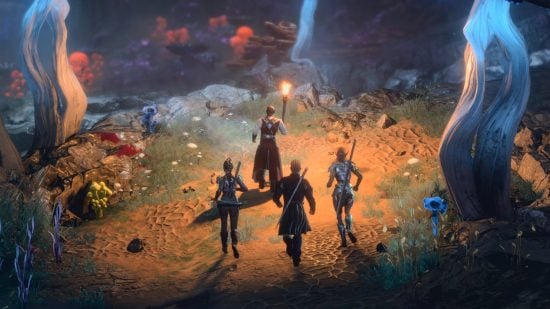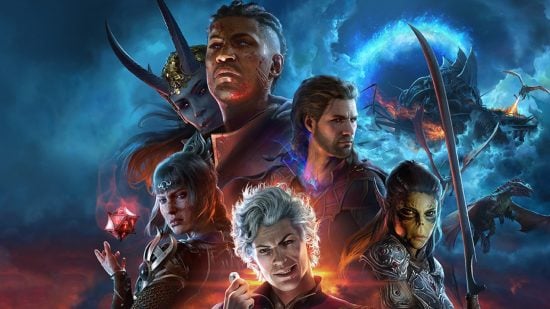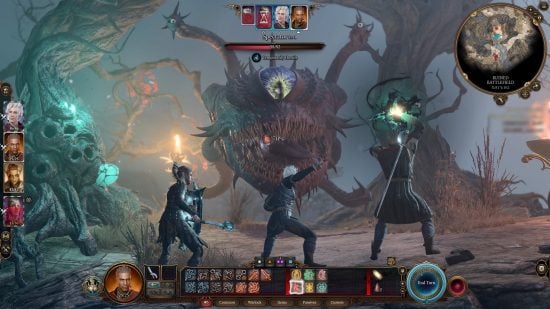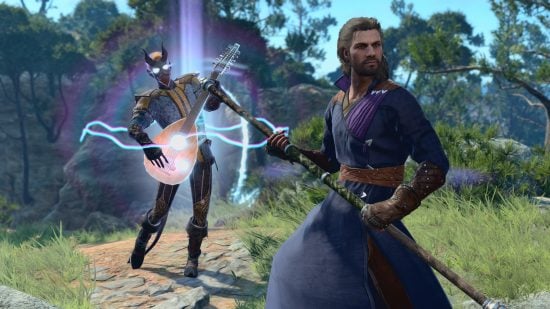There’s no wrong way to build a Baldur’s Gate 3 party, but there are certain compositions that’ll get you more bang for your buck. Yes, it’s possible (and fun) to build a party that’s only great at one thing, but a more balanced BG3 party will unlock the most gameplay opportunities. If you need help building your perfect Baldur’s Gate 3 party composition, we’re here to help.
Below is general advice for combining different Baldur’s Gate 3 companions and Baldur’s Gate 3 classes. Whether you’ve got a specific Baldur’s Gate 3 build or Baldur’s Gate 3 romance in mind, we can help you craft an adventuring party to suit. And, if you’re planning on trying some Baldur’s Gate 3 co-op, our suggestions can help you and your friends plan how to play.
What makes a good Baldur’s Gate 3 party?
Party roles
Just as in D&D, an optimized Baldur’s Gate 3 party is one that can carry out a variety of roles. We tabletop players have names for a lot of these roles:
- Tank – Takes a lot of hits and draws damage away from other party members.
- Support – Buffs their allies, debuffs their foes, and influences battle with non-combat methods.
- Face – Has high Charisma and handles social situations.
- Striker – A powerful combatant who focuses on dealing a lot of damage as quickly as possible.
- Blaster – Someone who deals damage through ranged offensive spells (often with area of effect to maximize impact.
- Healer – Has plenty of spells or class features that keep party hit points high.
- Scout – A high-Dex character who sneaks ahead to scout for enemies and disarm traps.
- Skills – Someone with a range of skill proficiencies who handles most out-of-combat skill checks.
- Utility Caster – A Magic user who offers lots of useful spells for non-combat situations (think Misty Step and Detect Thoughts).
A single party member can fill multiple roles. For example, Astarion is a DnD Rogue, so he has high Dexterity, high Charisma, and access to features like Sneak Attack. This means he’s a great Face, Scout, and Striker for your party.

Here are the typical party roles each companion can fill:
| Name | Class | Roles |
| Astarion | Rogue | Face, Scout, Striker, Skills |
| Gale | Wizard | Blaster, Utility Caster, Support, Skills |
| Shadowheart | Cleric | Healer, Support, Utility Caster |
| Lae’zel | Fighter | Striker, Tank |
| Wyll | Warlock | Blaster, Face, Support |
| Karlach | Barbarian | Striker, Tank |
| Halsin | Druid | Support, Scout, Tank, Healer |
| Jaheira | Druid | Support, Scout, Tank, Healer |
| Minsc | Ranger | Scout, Striker, Support |
| Minthara | Paladin | Face, Support, Healer, Striker, Tank |
There are also three DnD classes not covered by companions you may choose for your custom character:
- Baldur’s Gate 3 Bard (Support, Skills, Face, Healer, Utility Caster)
- Baldur’s Gate 3 Monk (Scout, Striker)
- Sorcerer (Face, Blaster, Utility Caster, Support)
You don’t necessarily need to tick all these boxes to make a great Baldur’s Gate 3 party, but having a good spread certainly helps you unlock your full potential. There’s a lot of overlap between different companions, too – so if you really hate one particular party member, there’ll be at least one that can (mostly) fill their shoes.

Personality
Every party member in Baldur’s Gate 3 has their own moral code and personal quests, and they’re not likely to stick around long if these are ignored. While it takes a lot of neglect to push a companion to leave completely, you should still be mindful of your companions’ personalities if you want a group that stays together for the long haul.
With these things in mind, here are some of our suggested Baldur’s Gate 3 party builds:
Beginner Baldur’s Gate 3 party
- Wizard (Blaster, Utility Caster, Skills)
- Cleric (Healer, Support, Utility Caster)
- Rogue (Scout, Face, Skills)
- Fighter (Striker, Tank)
It’s no coincidence that the first companions you meet form the best beginner Baldur’s Gate 3 party. These classes give a decent spread of your most important party roles. Plus it means you can stay loyal to your very first party, taking them right to the end of the game.
Heroic Baldur’s Gate 3 party
- Wizard (Blaster, Utility Caster, Skills)
- Druid (Support, Scout, Tank, Healer)
- Barbarian (Striker, Tank)
- Warlock (Face, Blaster)
This party is designed for those who want to hold onto the noblest NPC companions. Your custom character can fill any one of these roles, and you can use Gale, Halsin/Jaheira, Karlach, and Wyll to fill the gaps. Shadowheart also has a pretty good heart, so you could swap out your Druid if you feel a more powerful healer trumps a Scout.
Evil Baldur’s Gate 3 party
- Paladin (Face, Support, Healer, Striker, Tank)
- Fighter (Striker, Tank)
- Cleric (Healer, Support, Utility Caster)
- Wizard (Blaster, Utility Caster, Skills)
It’s slightly more challenging to build an optimized evil Baldur’s Gate 3 party – purely because there are far fewer companions who will agree with your actions. Minthara the Baldur’s Gate 3 Paladin is the most obvious choice, and luckily the Paladin can fill a variety of roles. After that, you’ll need to consider who is most likely to tag along with your terrible deeds – Astarion and Lae’zel are likely your best options (though we’re still waiting to see how they react to late-game story beats on an evil run).
Ideally, we need Shadowheart and Gale to turn to the dark side (we’re also still trying to figure out if this is entirely possible). But if we can’t get them on board, your character may need to fill some gaps here.
Baldur’s Gate 3 party for every class
If you’ve got a specific class you want to play, here are some recommended Baldur’s Gate 3 party compositions:
Baldur’s Gate 3 party for Bard
- Barbarian/Fighter (Karlach/Lae’zel)
- Wizard (Gale)
- Druid (Halsin/Jaheira)
Baldur’s Gate 3 party for Barbarian
- Cleric (Shadowheart)
- Rogue (Astarion)
- Wizard (Gale)
Baldur’s Gate 3 party for Cleric
- Cleric (Shadowheart)
- Barbarian/Fighter (Karlach/Lae’zel)
- Rogue (Astarion)
It may seem strange to have two Clerics in your party, but it works because of how versatile the different subclasses are. We personally like to build a Tempest Domain Cleric, who functions as a Blaster and Support character, and leave all the healing to Shadowheart.
Baldur’s Gate 3 party for Druid
- Warlock (Wyll)
- Barbarian/Fighter (Karlach/Lae’zel)
- Cleric (Shadowheart)
Baldur’s Gate 3 party for Fighter
- Cleric (Shadowheart)
- Wizard (Gale)
- Rogue (Astarion)
Baldur’s Gate 3 party for Monk
- Wizard (Gale)
- Barbarian/Fighter (Karlach/Lae’zel)
- Cleric (Shadowheart)
Baldur’s Gate 3 party for Paladin
- Wizard (Gale)
- Druid (Halsin/Jaheira)
- Cleric (Shadowheart)
The Paladin can fill a range of roles, but you don’t want them spread too thin. Once again, Shadowheart is the OP choice to take on some of the party’s healing responsibilities.
Baldur’s Gate 3 party for Ranger
- Barbarian/Fighter (Karlach/Lae’zel)
- Cleric (Shadowheart)
- Warlock (Wyll)
Baldur’s Gate 3 party for Rogue
- Cleric (Shadowheart)
- Barbarian/Fighter (Karlach/Lae’zel)
- Wizard (Gale)
Baldur’s Gate 3 party for Sorcerer
- Barbarian/Fighter (Karlach/Lae’zel)
- Cleric (Shadowheart)
- Rogue (Astarion)
Baldur’s Gate 3 party for Warlock
- Barbarian/Fighter (Karlach/Lae’zel)
- Cleric (Shadowheart)
- Rogue (Astarion)
Baldur’s Gate 3 party for Wizard
- Barbarian/Fighter (Karlach/Lae’zel)
- Cleric (Shadowheart)
- Rogue (Astarion)
Need more help with character creation? Here’s our advice on Baldur’s Gate 3 races, Baldur’s Gate 3 skills, and Baldur’s Gate 3 feats.







